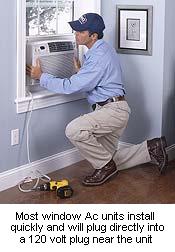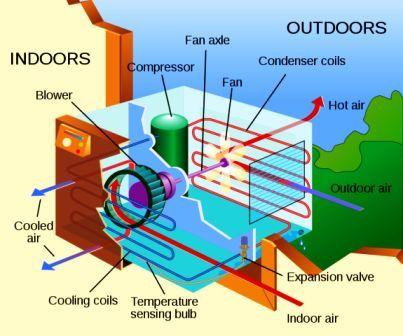|
WINDOW AIR CONDITIONERS
If you are familiar with our previous air conditioning pages, then you probably have the basic concept of how a freon-based air conditioner works. The typical conventional residential air conditioner is a split-system, which means that the 2 main components of the air conditioner are located in different locations. The air handler, or furnace, and AC coil are located indoors and the condensing unit is located outside. The two are connected with copper lines, which transfer heat outside, via a freon, which circulates through the system. The window air conditioner operates under the same principals as a conventional air conditioner, except that all the components are located inside the cabinet of the window AC unit. The front of the unit is the air distribution component with the indoor evaporator coil, and the rear of the unit acts as the outdoor condensing unit of the conventional system. This type of window AC unit could be chosen for various reasons, such as economy, size of area needing to be air conditioned, intended use of the space, or perhaps an addition to a conventional system cooling the rest of the residence. This option could also be considered if installation of a conventional system is not practical due to the characteristics of the home.
This image is reproduced from Wikipedia. It's author is Pbroks13.
Spot Cooling Keep in mind that a freon-based window air conditioner is not the only room air conditioner option. Spot cooling can be accomplished with portable air conditioners, window or portable swamp coolers, permanently mounted through-the-wall package AC units, and ductless split air conditioners, which we will discuss on a different page.
Read about Ductless Split Air Conditioners - click here
Just as we discussed earlier in our conventional AC pages, when choosing a window AC unit, size is just as important. A unit that is too small will simply run constantly and never reach the desired temperature. Also, if you buy a unit that's too big for the space, it can actually be less effective than a unit sized properly for the space. Bigger is not necessarily better.
All air conditioners, except swamp coolers, work by removing both heat and humidity. Humidity condenses from the air when it passes over the air conditioner's cooling coil. Therefore, a unit that is too large will cycle too rapidly to remove humidity properly. As a result, the room will feel damp and less comfortable. The properly sized unit will effectively remove humidity as it cools the space. Then there is the cost issue. A larger unit will cost more to purchase, and will consume more energy to operate. Running a smaller properly sized unit for a longer period of time will use less energy to cool a room than running a larger unit for a shorter time.
"Rule of Thumb" sizing for room air conditioners Capacity is measured in BTUs, or British Thermal Units, per hour. To figure the size unit you need, find the square footage of the space you intend to cool. Square footage is width of the space X length of the space.
Add 600 btu for each person regularly occupying the space, in excess of 2 occupants. Add 10% capacity if the space is heavily in the sun. Add 4,000 btu if the unit covers a kitchen.
Filters All air conditioners have a filtration system to keep the coils free from blockage. THIS IS VERY IMPORTANT! Clean or replace the filters often. Make sure, upon purchase, that the unit you select is easily serviceable.
Additional Recommendations Just the same as a conventional air conditioning system, a window AC unit's EER and SEER ratings should be considered before purchasing. These ratings are energy efficiency ratios. The higher the number, the less the unit will cost to operate. Also check out Energy Star ratings. Some window AC units are built to meet strict Energy Star criteria, such as, high efficiency compressors, high efficiency fan motors, cycling limiters, and timed on/off circuits.
Leave Window AC and Return to Air Conditioning main page
Please feel free to link to this page from your website. This page's URL is: http://www.perfect-home-hvac-design.com/window-ac.html
|
| ||||




 If your intentions are to cool a small space in your home, one or two rooms, the window air conditioner would be a much more economical choice when compared to the cost of the installation of a conventional central air conditioner, but would also cost less to operate.
If your intentions are to cool a small space in your home, one or two rooms, the window air conditioner would be a much more economical choice when compared to the cost of the installation of a conventional central air conditioner, but would also cost less to operate.

